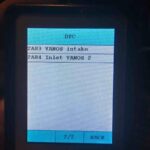Understanding the anti-theft system in your 2001 Ford Ranger is crucial, especially when dealing with starting issues. The Passive Anti-Theft System (PATS) is designed to prevent vehicle theft, and while OBD2 scanners are commonly used for diagnostics, their role in PATS related problems requires specific understanding. This article will delve into how PATS works in your 2001 Ford Ranger and whether a standard OBD2 scanner can help when you encounter PATS issues.
Decoding the 2001 Ford Ranger PATS System
The PATS system in your 2001 Ford Ranger is an immobilizer system. It’s designed to prevent the engine from starting unless the correct key is used. Here are the key components that make up the PATS system:
- PATS Transceiver: Located around the ignition cylinder on the steering column, the transceiver is the communicator. It reads the microchip embedded in your Ford Ranger key.
- Encoded Ignition Key: Your PATS key contains a transponder chip. This chip has a unique electronic code that the transceiver needs to recognize.
- Instrument Panel Cluster (IPC): In the 2001 Ford Ranger, the IPC is the brain of the PATS system. It receives the key code from the transceiver, validates it, and then sends authorization to the Powertrain Control Module (PCM).
- Powertrain Control Module (PCM): The PCM controls the engine functions. When it receives the “go-ahead” signal from the IPC, it allows the engine to start by enabling the fuel injectors and starter relay.
During a normal start sequence, when you turn the ignition key to the ON or START position, the IPC sends a signal to the PATS transceiver. The transceiver then interrogates the key, reads the transponder code, and sends this information back to the IPC. If the IPC recognizes the code as valid, it sends a message to the PCM, allowing your Ford Ranger to start. If the key code is not recognized, the PATS system prevents the engine from starting, and the anti-theft light on your dashboard will typically flash or stay illuminated.
Can an OBD2 Scanner Diagnose 2001 Ford Ranger PATS Issues?
Standard OBD2 scanners are primarily designed to diagnose issues related to your vehicle’s emissions and engine management systems. They are excellent for reading generic diagnostic trouble codes (DTCs) related to the powertrain, but their capability with systems like PATS is limited.
While a generic OBD2 scanner might read some DTCs related to PATS stored in the PCM or IPC, it typically cannot perform advanced PATS diagnostics or key programming. For example, if your 2001 Ford Ranger has a PATS issue, you might see a generic code related to engine starting problems, but the OBD2 scanner will likely not pinpoint the problem to the PATS system specifically or provide detailed PATS fault codes.
To effectively diagnose PATS issues on your 2001 Ford Ranger, you generally need a more advanced scan tool. This could include:
- Professional-grade Scan Tools: These scanners, often used by mechanics, have enhanced capabilities and can access systems beyond basic OBD2 functions, potentially including PATS diagnostics and key programming.
- Ford Specific Scan Tools: Tools like Ford IDS (Integrated Diagnostic System) or similar dealer-level tools provide the most comprehensive diagnostic and programming capabilities for Ford vehicles, including in-depth PATS functions.
Therefore, while your OBD2 scanner is a valuable tool for many car issues, for specific PATS problems on your 2001 Ford Ranger, it might only offer limited insight.
Common 2001 Ford Ranger PATS Problems
Understanding potential PATS issues can help you troubleshoot starting problems in your 2001 Ford Ranger. Common causes for PATS malfunctions include:
- Damaged PATS Key: If the transponder chip in your key is damaged, the transceiver may not be able to read it correctly.
- Non-Programmed PATS Key: If you use a new key that hasn’t been programmed to your vehicle’s PATS system, it won’t be recognized.
- Non-PATS Key: Using a regular key without a transponder chip will also prevent the vehicle from starting.
- Damaged Wiring: Faulty wiring in the PATS circuit can disrupt communication between components.
- Damaged Transceiver: A malfunctioning transceiver won’t be able to read the key code.
- Damaged IPC or PCM: If the IPC or PCM, which are integral to the PATS system, are damaged, the system will not function correctly.
If you suspect a PATS issue is preventing your 2001 Ford Ranger from starting, and your OBD2 scanner isn’t providing enough information, seeking professional diagnosis with specialized tools is advisable. A qualified mechanic or Ford dealership will have the equipment to accurately diagnose and repair PATS related problems, including key programming and component replacement if necessary.
